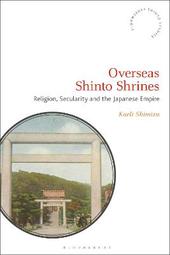
|
Overseas Shinto Shrines: Religion, Secularity and the Japanese Empire
Hardback
Main Details
| Title |
Overseas Shinto Shrines: Religion, Secularity and the Japanese Empire
|
| Authors and Contributors |
By (author) Karli Shimizu
|
| Series | Bloomsbury Shinto Studies |
|---|
| Physical Properties |
| Format:Hardback | | Pages:296 | | Dimensions(mm): Height 234,Width 156 |
|
| Category/Genre | Asian and Middle Eastern history
Shintoism |
|---|
| ISBN/Barcode |
9781350234987
|
| Classifications | Dewey:299.561350952 |
|---|
| Audience | | Professional & Vocational | |
|---|
| Illustrations |
10 bw illus
|
|
Publishing Details |
| Publisher |
Bloomsbury Publishing PLC
|
| Imprint |
Bloomsbury Academic
|
| Publication Date |
6 October 2022 |
| Publication Country |
United Kingdom
|
Description
Through extensive use of primary resources and fieldwork, this detailed study examines overseas Shinto shrines and their complex role in the colonization and modernization of newly Japanese lands and subjects. Shinto shrines became one of the most visible symbols of Japanese imperialism in the early 20th century. From 1868 to 1945, shrines were constructed by both the government and Japanese migrants across the Asia-Pacific region, from Sakhalin to Taiwan, and from China to the Americas. Drawing on theories about the constructed nature of the modern categories of 'religion' and the 'secular', this book argues that modern Shinto shrines were largely conceived and treated as secular sites within a newly invented Japanese secularism, and that they played an important role in communicating changed conceptions of space, time and ethics in imperial subjects. Providing an example of the invention of a non-Western secularity, this book contributes to our understanding of the relationship between religion, secularism and the construction of the modern state.
Author Biography
Karli Shimizu is an affiliated researcher at the Research Faculty of Media and Communication of Hokkaido University, Japan.
ReviewsEngaging with wider debates on the difficult divide between secular patriotic ritual and religious ritual, this monograph presents the first full-length study of Shinto shrines established in the ever-expanding Japanese sphere of influence between the late 19th and mid-20th centuries. Through her well-researched study, Shimizu discusses how Japan attempted to construct a multiethnic Shinto-based secularity and used the overseas Shinto shrines to instill new senses of time, space and morality in their newly acquired territories. * Ellen Van Goethem, Professor of Japanese History, Kyushu University, Japan *
|